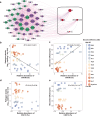Interactions with native microbial keystone taxa enhance the biocontrol efficiency of Streptomyces
- PMID: 40390122
- PMCID: PMC12087250
- DOI: 10.1186/s40168-025-02120-y
Interactions with native microbial keystone taxa enhance the biocontrol efficiency of Streptomyces
Erratum in
-
Correction: Interactions with native microbial keystone taxa enhance the biocontrol efficiency of Streptomyces.Microbiome. 2025 Jun 20;13(1):148. doi: 10.1186/s40168-025-02171-1. Microbiome. 2025. PMID: 40542433 Free PMC article. No abstract available.
Abstract
Background: Streptomyces spp. are known for producing bioactive compounds that suppress phytopathogens. However, previous studies have largely focused on their direct interactions with pathogens and plants, often neglecting their interactions with the broader soil microbiome. In this study, we hypothesized that these interactions are critical for effective pathogen control. We investigated a diverse collection of Streptomyces strains to select those with strong protective capabilities against tomato wilt disease caused by Ralstonia solanacearum. Leveraging a synthetic community (SynCom) established in our lab, alongside multiple in planta and in vitro co-cultivation experiments, as well as transcriptomic and metabolomic analyses, we explored the synergistic inhibitory mechanisms underlying bacterial wilt resistance facilitated by both Streptomyces and the soil microbiome.
Results: Our findings indicate that direct antagonism by Streptomyces is not sufficient for their biocontrol efficacy. Instead, the efficacy was associated with shifts in the rhizosphere microbiome, particularly the promotion of two native keystone taxa, CSC98 (Stenotrophomonas maltophilia) and CSC13 (Paenibacillus cellulositrophicus). In vitro co-cultivation experiments revealed that CSC98 and CSC13 did not directly inhibit the pathogen. Instead, the metabolite of CSC13 significantly enhanced the inhibition efficiency of Streptomyces R02, a highly effective biocontrol strain in natural soil. Transcriptomic and metabolomic analyses revealed that CSC13's metabolites induced the production of Erythromycin E in Streptomyces R02, a key compound that directly suppressed R. solanacearum, as demonstrated by our antagonism tests.
Conclusions: Collectively, our study reveals how beneficial microbes engage with the native soil microbiome to combat pathogens, suggesting the potential of leveraging microbial interactions to enhance biocontrol efficiency. These findings highlight the significance of intricate microbial interactions within the microbiome in regulating plant diseases and provide a theoretical foundation for devising efficacious biocontrol strategies in sustainable agriculture. Video Abstract.
Keywords: Paenibacillus; Stenotrophomonas; Streptomyces; Microbial interaction; Multi-omics analysis; Synthetic community; Tomato bacterial wilt.
© 2025. The Author(s).
Conflict of interest statement
Declarations. Ethics approval and consent to participate: Not applicable. Consent for publication: Not applicable. Competing interests: The authors declare no competing interests.
Figures







Similar articles
-
Rhizobacterium streptomyces sp. NEAU-383 as a potential biocontrol agent to control tomato bacterial wilt.Braz J Microbiol. 2025 Jun;56(2):1179-1189. doi: 10.1007/s42770-025-01645-6. Epub 2025 Feb 26. Braz J Microbiol. 2025. PMID: 40011423
-
Organic fertilizer enhances the secretion of microRNAs from tomato roots to facilitate beneficial rhizosphere microorganism expansion and suppress Ralstonia solanacearum proliferation.Microbiome. 2025 Jul 5;13(1):159. doi: 10.1186/s40168-025-02137-3. Microbiome. 2025. PMID: 40618122 Free PMC article.
-
Biocontrol mechanism of a newly isolated Streptomyces sp. JL2001 against Ralstonia solanacearum via aerugine.Pestic Biochem Physiol. 2025 Sep;213:106517. doi: 10.1016/j.pestbp.2025.106517. Epub 2025 Jun 26. Pestic Biochem Physiol. 2025. PMID: 40744559
-
Biocontrol of plant pathogens by actinomycetes: a bibliometric analysis and systematic review.World J Microbiol Biotechnol. 2025 Jul 2;41(7):243. doi: 10.1007/s11274-025-04422-7. World J Microbiol Biotechnol. 2025. PMID: 40593367
-
Root architecture and the rhizosphere microbiome: Shaping sustainable agriculture.Plant Sci. 2025 Oct;359:112599. doi: 10.1016/j.plantsci.2025.112599. Epub 2025 Jun 5. Plant Sci. 2025. PMID: 40482721 Review.
Cited by
-
A stable 15-member bacterial SynCom promotes Brachypodium growth under drought stress.Front Microbiol. 2025 Aug 11;16:1649750. doi: 10.3389/fmicb.2025.1649750. eCollection 2025. Front Microbiol. 2025. PMID: 40862137 Free PMC article.
-
Correction: Interactions with native microbial keystone taxa enhance the biocontrol efficiency of Streptomyces.Microbiome. 2025 Jun 20;13(1):148. doi: 10.1186/s40168-025-02171-1. Microbiome. 2025. PMID: 40542433 Free PMC article. No abstract available.
References
-
- Mendes R, Kruijt M, De Bruijn I, Dekkers E, Van Der Voort M, Schneider JH, et al. Deciphering the rhizosphere microbiome for disease-suppressive bacteria. Science. 2011;332(6033):1097–100. 10.1126/science.1203980. - PubMed
-
- Liu H, Brettell LE. Plant defense by VOC-induced microbial priming. Trends Plant Sci. 2019;24(3):187–9. 10.1016/j.tplants.2019.01.008. - PubMed
-
- Chen XH, Koumoutsi A, Scholz R, Schneider K, Vater J, Süssmuth R, et al. Genome analysis of Bacillus amyloliquefaciens FZB42 reveals its potential for biocontrol of plant pathogens. J Biotechnol. 2009;140(1–2)(-):27–37. 10.1016/j.jbiotec.2008.10.011. - PubMed
MeSH terms
Grants and funding
- 42090064, 42325704 and 42377118/National Natural Scientific Foundation of China
- 42090064, 42325704 and 42377118/National Natural Scientific Foundation of China
- 42090064, 42325704 and 42377118/National Natural Scientific Foundation of China
- 42090064, 42325704 and 42377118/National Natural Scientific Foundation of China
- 2023YFD1701501/National Key Research and Development Program of China
LinkOut - more resources
Full Text Sources
Miscellaneous

